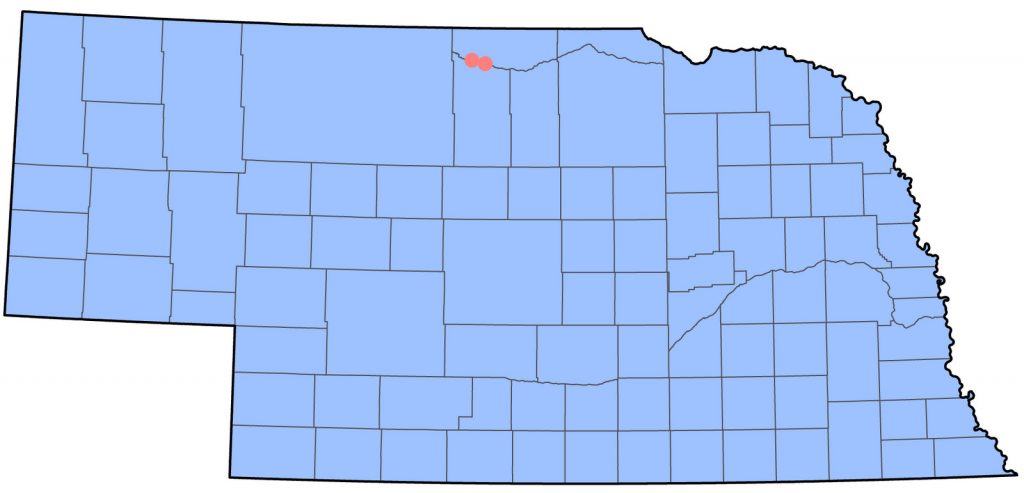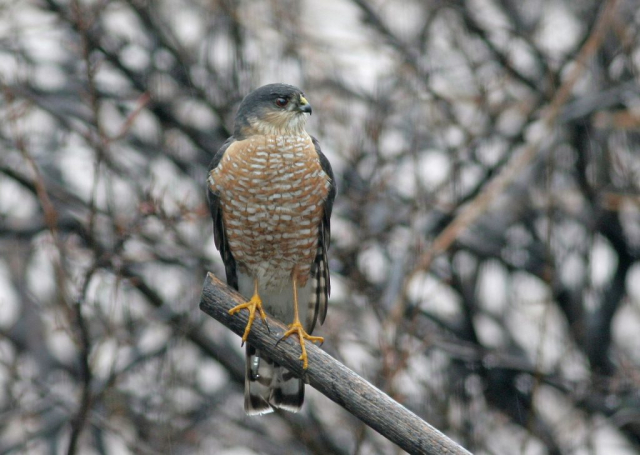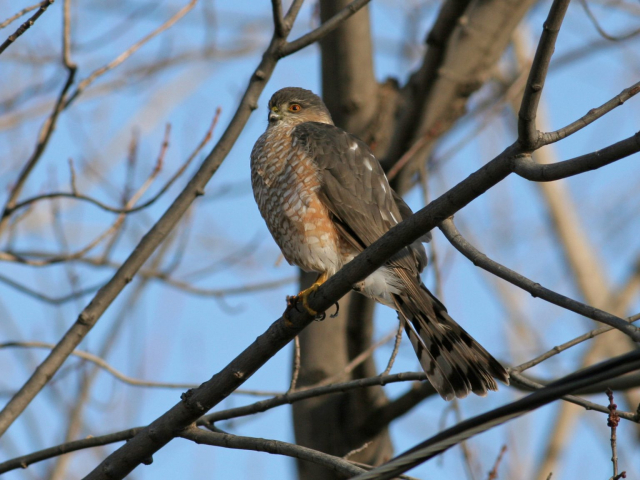Accipiter striatus velox
Status: Uncommon, locally common, regular spring and fall migrant statewide. Rare casual breeder north. Uncommon regular winter visitor statewide.

Documentation: Specimen: UNSM ZM12494, 23 Aug 1908 Monroe Canyon, Sioux Co.
Taxonomy: AviList (2025) recognizes 10 subspecies throughout the Americas, two of these in North America, perobscurus of Queen Charlotte Is, British Columbia, and velox throughout Canada, United States, and most of Mexico.
Three of the 10 subspecies listed by AviList (2025) have been considered full species (Ferguson-Lees and Christie 2005, Gill et al 2024), but a comprehensive genetic review of all 10 is needed (AviList); the three are chionogaster White-breasted Hawk from Mexico to Nicaragua, ventralis Plain-breasted Hawk from Venezuela to Bolivia, and erythronemius Rufous-thighed Hawk from Bolivia and Brazil to Argentina.
Nebraska birds are presumed velox. Occurrence of perobscurus as a migrant in Nebraska is unlikely; Bildstein and Meyer (2020) note that it is only partly migratory, reaching Oregon and possibly farther south.
Spring: winter<<<>>> May 26, 28, 28
Migrants pass through mostly in Apr and early May, with peak counts in mid-Apr. Jun sightings are mostly juveniles (Wheeler 2003), such as singles 9 Jun 2011 Custer Co, 10 Jun 2005 Dawson Co, and 21 Jun 2016 Fort Niobrara NWR, Cherry Co.
- High counts: 5 in the eastern Rainwater Basin 17 Apr 2011, 5 at Bassway Strip WMA, Buffalo Co 12 Mar 2024, and 4 in Kimball Co 14 Apr 2001.
Summer: Evidence for breeding of this species in Nebraska is sparse. It is secretive during the breeding season and generally stays within the canopy of both coniferous and deciduous forest, making it difficult to locate.
The best evidence is from the central Niobrara River Valley and the Pine Ridge. Youngworth (1955) considered it a “resident in small numbers” in the central Niobrara River Valley, and Mossman and Brogie (1983) had several sightings of two breeding pairs and a possible third at three sites in the Niobrara Valley Preserve Apr-May 1982. One of the breeding pairs, both parents in immature plumages, had four eggs in Brown Co 6 Jun; young had fledged by 25 Aug (Mossman and Brogie 1983). One was at Fort Niobrara NWR, Cherry Co 21 Jun 2016, but its age class was not noted.
Evidence from the Pine Ridge is weaker but breeding probably occurs there (Rosche 1982). Mollhoff (2022) listed three old records of nests with eggs from Sioux Co 30 May-10 Jul 1900-1901. Roger Sharpe (personal communication) secured a male with enlarged testes 19 Jun 1968 in typical ponderosa pine habitat at the head of Little Monroe Canyon, Sioux Co. A “possible nest” was reported from the Fort Robinson area 14 Jun 2006.
The only reports elsewhere are of an adult carrying food to a nest in Sherman Co in 1981 (Ducey 1988), and an apparently successful nesting in 1994 in northern Saunders Co, where a territorial pair was observed in spring through late Jun and an immature was heard 6 Aug (Silcock and Rosche 1994). An old record was of a nest with eggs near Ashland, Saunders Co 14 May 1895, one egg now #95576 at University of Kansas Biodiversity Unit, Lawrence, KS (Mollhoff 2022).
Breeding season reports in northern and western Nebraska may be non-breeding one-year-olds; there are several such reports from Scotts Bluff Co, 11 Jun 1995, Jun 1996, 13 Jun 2022, 14 Jun 2021, 19 Jun 2001, 4 Jul 1999, and 4 Aug 1997, and one for southeastern Garden Co 22 Jul 2024. One was in Knox Co 1 Aug 2024.
There are at least 42 reports Jun-10 Aug. Most are from southeast Nebraska; since there is only one documented breeding record in that area it is likely that many of these reports are mis-identified male Cooper’s Hawks, although some may be non-breeding one-year old Sharp-shinned Hawks (Wheeler 2003).
Fall: Aug 16, 17, 18 <<<>>> winter
An earlier date is 10 Aug 2023 NNF McKelvie, Cherry Co.
Reports on early dates in fall are suspect due to presence in summer statewide of Cooper’s Hawks; small Cooper’s and large Sharp-shins can be difficult to separate. Migratory Sharp-shinned Hawks become noticeable in early Sep, with peak numbers from mid-Sep to mid-Oct. Data from the Hitchcock Hawk Watch, just across the Missouri River from Washington Co, Nebraska, show arrival in mid-Aug, and an average count per fall 2002-2022 of 825 Sharp-shinned Hawks compared with only 248 Cooper’s Hawks (Hawkcount.org, accessed Oct 2023).
- High count: 41 at Camp Wakonda, Sarpy Co, 21 Sep 1998.
Winter: Winter records are statewide, except for the treeless grasslands of the Sandhills. Reports are fewest in mid-Jan. Some individuals frequent urban neighborhoods during the winter, preying upon passerines that are attracted to bird feeders. CBC data 1990-2015 indicate a 1.7: 1 ratio of Sharp-shinned to Cooper’s.
- High counts: 11 on the Branched Oak-Seward CBC 17 Dec 2005, 7 there 14 Dec 2003, 7 there 17 Dec 2009, 7 there 14 Dec 2019, 7 on the DeSoto NWR CBC 2 Jan 2011, and 7 on the Lake McConaughy CBC 31 Dec 2011.
Images
Abbreviations
CBC: Christmas Bird Count
NWR: National Wildlife Refuge
UNSM: University of Nebraska State Museum
Literature Cited
AviList Core Team, 2025. AviList: The Global Avian Checklist, v2025. https://doi.org/10.2173/avilist.v2025.
Bildstein, K.L., K.D. Meyer, C.M. White, J.S. Marks, and G.M. Kirwan. 2020. Sharp-shinned Hawk (Accipiter striatus), version 1.0. In Birds of the World (S. M. Billerman, B. K. Keeney, P. G. Rodewald, and T. S. Schulenberg, Editors). Cornell Lab of Ornithology, Ithaca, NY, USA. https://doi.org/10.2173/bow.shshaw.01
Ducey, J.E. 1988. Nebraska birds, breeding status and distribution. Simmons-Boardman Books, Omaha, Nebraska, USA.
Ferguson-Lees, D.A., and J.A. Christie. 2005. Raptors of the world: a field guide. Christopher Helm, London.
Gill, F., D. Donsker, and P. Rasmussen (Eds). 2024. IOC World Bird List (v 14.2). Doi 10.14344/IOC.ML.14.2. http://www.worldbirdnames.org/.
Mollhoff, W.J. 2022. Nest records of Nebraska birds. Nebraska Ornithologists’ Union Occasional Paper Number 9.
Mossman, M.J., and M.A. Brogie. 1983. Breeding status of selected bird species on the Niobrara Valley Preserve, Nebraska. NBR 51: 52-62.
Rosche, R.C. 1982. Birds of northwestern Nebraska and southwestern South Dakota, an annotated checklist. Cottonwood Press, Crawford, Nebraska, USA.
Silcock, W.R., and R.C. Rosche. 1994. Fall Field Report, August-November 1994. NBR 62: 126-149.
Wheeler, B.K. 2003. Raptors of Western North America. Princeton University Press, New Jersey, USA.
Youngworth, W. 1955. Some birds of the Quicourt Valley. NBR 23: 29-34.
Recommended Citation
Silcock, W.R., and J.G. Jorgensen. 2025. Sharp-shinned Hawk (Accipiter striatus). In Birds of Nebraska — Online. www.BirdsofNebraska.org
Birds of Nebraska – Online
Updated 13 Jul 2025


